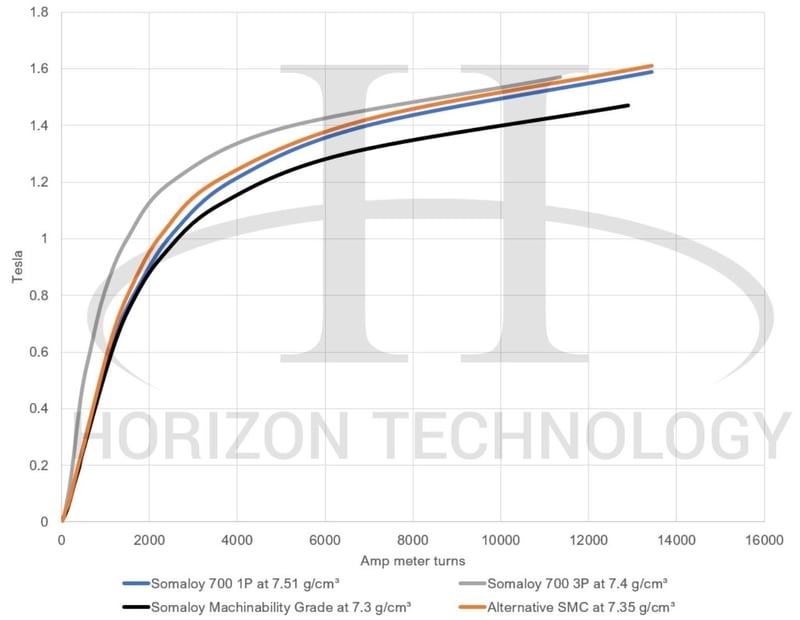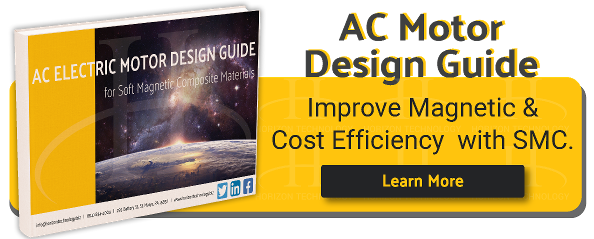In metal components production, prototyping is often a necessary evil so you can evolve your engineering design and, eventually, get the best final product possible.
Let’s say you add the unknown (to you, at least) of powder metallurgy to the mix. How can you and your manufacturing partner streamline prototype-to-production transition, condense the project schedule, and optimize your value in this unknown realm?
Before they start a prototype motor component, most engineers want a model -- and a set of raw data to determine whether they’re in the right ballpark. So before you even go through that discussion of prototyping methods, can your partner supply you with the necessary production intent data (such as B-H curves and core losses) to model your magnetic characteristics?

(Comparison of SMC production-grade materials to Somaloy prototyping materials)
In other words, can your manufacturer supply you production results instead of just lab results? We can -- so let’s take this talk to the next stage.
Prototype Motor Component Options for Electric Applications
Once you have the data mentioned above, you can then consider making a prototype.
Building a part that requires soft magnetic material qualities? You’re likely familiar with the process of prototyping a traditional, stamped steel lamination. But when it comes to powder metallurgy, there are two options for approaching prototyping of a soft magnetic part: machining and molding (aka compacting). As you may have guessed, there are positives and negatives for both machining and molding.
Let’s look at the benefits and challenges that come with metal part prototyping with soft magnetic composites made from powder metal:
Why Is Your Metal Part Prototyping Decision so Important With Soft Magnetics?
The primary goal of prototyping a powder metal part is to validate the model before moving it to production. Sounds familiar, right? Even though there are inherent challenges, creating a prototype of a powder metal (PM) part is a smart way to evaluate your design.
Soft magnetic composites (SMCs), a staple set of materials in powder metallurgy, have their own set of prototyping challenges. But it’s likely worth it if you consider the other benefits of SMCs vs. electrical steel laminates.
So which way to go: molding or machining?
Here’s the short version. The potential disadvantages of machining a prototype part made from SMC include:
- Lack of a true manufacturing process validation
- Quality compromises (breakage, internal cracking, magnetic performance, etc.)
- Cost inefficiency, depending on the number of test parts you need
By compacting the part instead, you don't suffer any drops in performance but do face a higher tooling cost. Although machining tends to decrease performance, its main advantage is a lower cost for a limited number of pieces.
And now, for the nitty-gritty details:
What Are the Challenges of Metal Prototyping With Soft Magnetic Materials?
Decline in Magnetic Performance
Using a conventional, prototype-grade material, you can expect about a 20% decrease in magnetic performance. But ideally you can predict this decline and then extrapolate it to the production-level material.
If optimal prototype performance matters to your project, compacting the test part is always a better option.
Breaking off Sharp Corners and Edges
Machining an SMC prototype risks damage to any sharp corners and edges on the part.
As such, we don't recommend machining as a secondary operation for a final production run.
Understanding the Costs of Low-Volume Prototyping
One of the benefits of powder metallurgy is that tooling costs are a one-time investment. If prototype tooling is successful, it carries the added value of being usable throughout final production.
Machining can be a more cost-effective method for prototyping because it doesn't require any tooling costs.
Machining vs. tooling isn’t a one-or-the-other choice. You just need to be aware of the compromises that come with machining a prototype part. Machining can be a stepping stone to build confidence in your design before you enter production.
It's not much fun to prototype with a $20K powder metal toolset, make 300 pieces, and then realize you need to make a design change.
Machining a 10-part prototype run may only require a few weeks and little effort.
Lack of Powder Metallurgy Data
For engineers encountering a new technology or material for the first time, it’s understandable if they have reservations about how it will perform in “real life.”
Historically, there hasn’t been the same amount of performance data available with powder metallurgy SMCs as there is with laminations. And what powder metallurgy data has existed was mostly theoretical.
This often left the buyer with questions and concerns, and it’s been hard for them to switch their entire way of assembly and enter that brave, new world.
Today, there’s no more need to “guess” on data. Horizon has developed a database of magnetic performance characteristics of both SMC materials and laminations that demonstrate the advantages of SMCs -- in real-life motor applications.
Strength
Typical machining operations are designed to produce parts from high-strength materials that take on tensile forces and impact loads. Normally with powder metal materials, no machining happens until post-sintering.
Since SMC parts don't go through the sintering furnace like other powder metal parts, they're more delicate than their sintered cousins. This means SMC parts undergo mechanical bonding (through compaction), but no metallurgical bond (through sintering).
The result? SMC parts are brittle to the point of breaking if you don’t properly consider tool selection, chip load, and part fixturing during machining as part of the prototyping process.
Have More Questions About Metal Part Prototyping?
Prototyping SMCs comes with several positive outcomes, especially when comparing them with laminations:
- More predictable performance
- Easier to translate into production
- Optimize your investment for a long-term solution
However, even with its host of advantages, metal part prototyping with soft magnetic composites has its share of challenges.
Notably, your powder metallurgy company should be able to provide you magnetic data for soft magnetic composite materials you can insert into your modeling programs. Whether you choose machining or compaction, your partner should provide the data and guidance to successfully take your part from design to production.
Your choice of a powder metallurgy partner is clear -- choose the one who can do it, and do it well.



